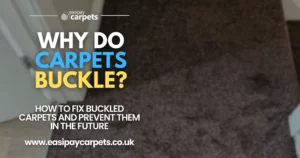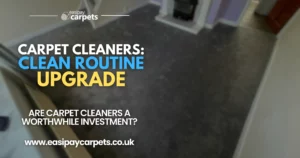

Your Ultimate Vinyl Flooring Care Guide
Introduction to Sheet Vinyl Flooring Care
Sheet vinyl flooring is a durable, water-resistant, and low-maintenance option, perfect for areas with heavy foot traffic, spills, and moisture exposure. Proper care not only keeps sheet vinyl looking fresh but also prolongs its lifespan. This guide will cover daily maintenance, stain removal, dealing with wear, and seasonal care tips to keep your vinyl floor in excellent condition.
After You’re Fit
Removing Excess Glue: Any adhesive on the surface of the vinyl can be removed with either rubbing alcohol or an adhesive remover. Use a soft cloth to remove the glue to avoid scratching the surface. For more info and a step-by-step guide read our post here.
Vacuuming: Please give the vinyl flooring a few hours for the glue to set before you vacuum – if it’s still wet and you vacuum immediately this can pull the flooring up.
Sealing Bathrooms: Vinyl Flooring is waterproof, but if you’re prone to big spills in certain rooms like bathrooms, consider sealing around the edge of the room. Any silicone sealant will work fine. You can smooth it out either by adding a small amount of dish soap to your finger and running it over the sealant, or by using something like a gift card with a rounded edge.
Avoid Sliding Heavy Appliances: Until the glue sets, avoid moving or sliding anything heavy across the flooring as it could drag the flooring with it, resulting in creases or splits. This is particularly important in kitchens when moving fridges or washing machines.
Routine Maintenance and Cleaning
Sweeping and Dusting
Regular dusting and sweeping help prevent scratches from dirt and debris.
- Frequency: Sweep daily or as needed, especially in high-traffic areas.
- Tools: Use a soft-bristle broom, dust mop, or vacuum with a hard floor setting to prevent damage.
Mopping and General Cleaning
While sheet vinyl is water-resistant, excess moisture should be avoided to protect the adhesive and keep the floor secure.
- Damp Mopping: Use a damp (not soaking wet) microfiber mop for regular cleaning. Avoid leaving standing water.
- Vinyl-Safe Cleaner: Opt for a vinyl-specific cleaner or a DIY solution of a few drops of mild dish soap in water. Avoid abrasives or harsh chemicals.
Spot Cleaning
Tackle spills and messes immediately to prevent staining and ensure easy clean-up.
- Blotting Spills: Use a soft, dry cloth to blot spills, then clean the area with a damp cloth and mild soap.
- Avoid Scrubbing: Gently dab or blot rather than scrubbing, as aggressive scrubbing can wear down the vinyl.
Deep Cleaning
Frequency and Methods
Occasional deep cleaning keeps sheet vinyl looking new, removing build-up that regular mopping may miss.
- Frequency: Deep clean every 1-2 months or as needed in high-traffic areas.
- DIY Cleaner: Use a mixture of water and a small amount of vinegar for a gentle, thorough clean. Ensure the mop is only lightly damp to avoid excess moisture.
- Avoid Harsh Products: Do not use bleach, ammonia, or abrasive cleaners, as these can damage vinyl over time.
Stain and Mark Removal
Common Stain Types and Solutions
Certain stains may require specific approaches for safe and effective removal.
- Food and Drink Stains: Use a mild soap and water solution to lift food and drink stains. For tough stains, a mix of water and white vinegar works well.
- Ink or Marker: Lightly dab the area with a soft cloth and rubbing alcohol, being careful not to scrub.
- Grease: Wipe away grease with a damp cloth and mild dish soap. Dry thoroughly to avoid slippery residue.
Stain Prevention Tips
- Rugs and Mats: Use mats in areas prone to spills, such as under kitchen sinks or near entryways.
- Quick Clean-up: The sooner a spill is addressed, the less likely it will cause staining.
Preventing Scratches and Scuffs
Furniture Protection and Rugs
Heavy furniture and frequent foot traffic can cause scuffs, dents, and scratches on vinyl.
- Furniture Pads: Place felt pads under furniture legs to prevent scratches. Avoid dragging heavy items across the floor.
- Area Rugs and Mats: In high-traffic areas, place rugs or mats to protect the vinyl from scuffing.
Pet Care Tips
- Trim Nails: Keep pets’ nails trimmed to avoid scratches.
- Pet Mats: Place mats under pet food and water bowls to prevent scratching and moisture damage.
Avoiding High Heels and Sharp Objects
- No Sharp Shoes: Avoid wearing high heels or shoes with hard soles on vinyl flooring to prevent dents.
- Be Mindful of Sharp Items: Keep sharp objects away from the floor surface to avoid accidental cuts or punctures.
Seasonal Care Tips
Winter Care
- Mud and Salt: Use entryway mats to capture mud and salt from winter shoes, as salt can cause discoloration over time.
- Frequent Sweeping: Dirt, mud, and salt can act like sandpaper on vinyl, so sweep regularly to prevent scratching.
Summer Care
- Humidity Control: Excessive humidity can sometimes affect sheet vinyl, especially near seams. Use fans or dehumidifiers to control moisture levels.
- Sunlight Protection: Prolonged sunlight exposure can cause discoloration. Use blinds or curtains to block direct sunlight if needed.
Long-Term Maintenance Tips
Avoid Excessive Water
While sheet vinyl is water-resistant, using too much water during cleaning can weaken the adhesive underneath. Stick to damp mopping and always dry spills immediately.
Use the Right Cleaning Products
- Vinyl-Safe Cleaners: Choose pH-neutral or vinyl-safe cleaners to avoid stripping the vinyl’s finish.
- Avoid Wax and Polish: Sheet vinyl does not require waxing or polishing, as it has a built-in protective layer. Wax products can leave a dull residue.
Handle Repairs Promptly
Minor issues may arise over time, but they can often be repaired without replacing the entire floor.
- Lifting Edges: If edges or seams begin to lift, reapply a vinyl adhesive to secure them.
- Repair Kits: Minor cuts or scratches can be repaired with vinyl floor repair kits.
Signs It’s Time to Replace Sheet Vinyl Flooring
Extensive Wear and Tear
If there are widespread scratches, fading, or permanent stains, replacement might be more cost-effective.
Persistent Lifting or Bubbling
If edges, seams, or bubbles consistently lift despite repairs, it may indicate adhesive failure or excessive wear.
Discoloration or Yellowing
Significant discoloration from sunlight or chemical reactions may be a sign to replace old sheet vinyl flooring.
Easipay Carpets can help you get brand new flooring without the high up-front cost – by simply letting you spread the cost of the flooring over time instead. There’s no interest on our plans so you aren’t spending a penny more than you would buying it outright and we include underlay, door trims, carpet grippers and laminate beading for free. Prices start from just £10 per week!
It starts with a free home appointment and quote, to get booked in at a time that suits you, tap the “Get Started” button below and fill out the contact form!
Still Got Questions? Here's 25 FAQs!
Sweep daily, damp mop weekly, and deep clean every 1-2 months.
No, steam can damage the adhesive and cause vinyl to warp or lift.
Use a mix of mild soap and water or water with a bit of vinegar to lift food stains gently.
Yes, a diluted solution (one part vinegar to three parts water) is safe and effective for cleaning.
Use felt pads under furniture, place rugs in high-traffic areas, and avoid sharp or heavy impacts.
Prolonged exposure to direct sunlight can cause fading. Use blinds or curtains to reduce exposure.
Blot with a damp cloth and mild soap, then dry thoroughly. Avoid soaking.
No, sheet vinyl doesn’t require polish, as it has a protective layer. Polishing can leave a residue.
Wipe with a cloth and mild dish soap, then rinse and dry the area.
Yes, use a hard floor setting or an attachment without a beater bar.
Ensure no water seeps under the vinyl, and use a moisture barrier if installing in humid areas.
Apply a vinyl adhesive to the lifted edge and press down firmly.
Yes, its water resistance makes it ideal for kitchens and bathrooms, but avoid excessive moisture.
Use a soft cloth with a little rubbing alcohol to gently rub away scuff marks.
No, use a damp (not wet) mop to avoid excess moisture on the floor.
A pH-neutral or vinyl-specific cleaner is best to maintain the finish.
Trim pets’ nails regularly and place rugs or mats in areas they frequent.
No, waxing is unnecessary and can damage the vinyl’s protective layer.
Yes, sheet vinyl’s water resistance makes it suitable for laundry rooms.
Lightly dab with rubbing alcohol on a cloth, being careful not to scrub.
Regular sweeping, gentle mopping, and using rugs in high-traffic areas will keep it looking fresh.
Small bubbles may settle over time, but persistent bubbles may require adhesive reapplication or replacement.
Use an enzyme-based cleaner for pet odors to break down the source of the smell. Wipe and dry the area thoroughly after application.
Yes, sheet vinyl can sometimes be installed over other floors if they’re clean, smooth, and in good condition. Check manufacturer guidelines for compatibility.
Sticky residue may be due to leftover cleaner. Wipe the area with clean water and a damp cloth to remove any remaining solution, and dry thoroughly.




